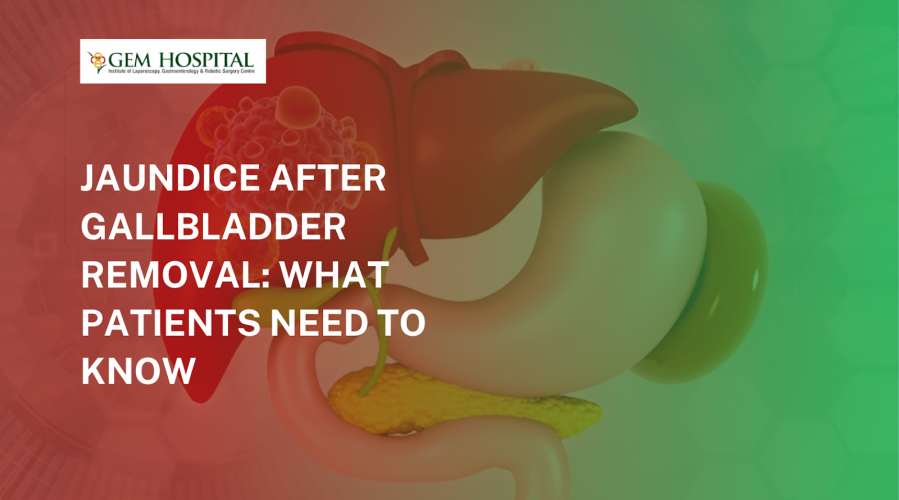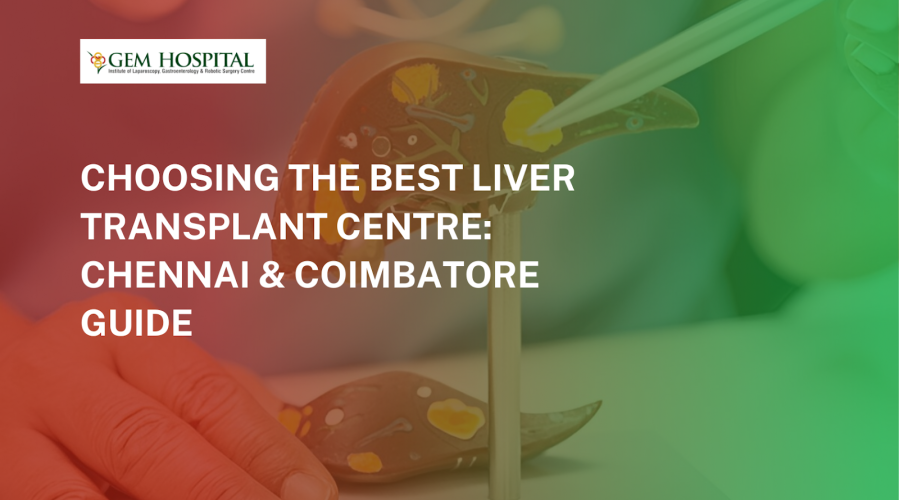Discover the latest advances in liver and kidney treatment at GEM Hospitals in Chennai and Coimbatore. Learn how our cutting-edge care and expert specialists set us apart from other healthcare providers.
Jaundice After Gallbladder Removal: What Patients Need to Know

Gallbladder removal, or cholecystectomy, is one of the most commonly performed surgeries in the world and most commonly performed on patients having either gallstones, gallbladder inflammation, or infection. Most patients have a successful recovery from the surgery, but some can experience some problems a few weeks or months after their surgery.
One concern of particular note is patients appearing jaundiced after their gallbladder has been taken out. Jaundice can be described as the yellowing of both the skin and the white of the eyes and it occurs because of increased levels of bilirubin in the blood. When patients notice these symptoms after their surgery, they are understandably concerned and confused. In this blog post, we will discuss causes, risks, symptoms and treatments of jaundice after gallbladder removal and when to go to the hospital.
Understanding Why Jaundice Occurs After Gallbladder Removal
The gallbladder forms part of the drainage system for bile that the liver creates. Bile is a digestive fluid produced by the liver. Once the gallbladder has been removed, the bile passes directly from the liver to the small intestine. In most circumstances patients end up coping with these changes in how bile is passed to the duodenum fairly well. However, problems arising as a complication of surgery that can inhibit normal flow of bile drainage can occur and lead to jaundice after gallbladder removal.
Common Causes of Post-Cholecystectomy Jaundice:
- Bile duct injury: During surgery, accidental injury to the bile ducts can occur. This may result in bile leakage or blockage, causing bile to accumulate in the bloodstream.
- Bile duct stricture: Scar tissue formation around the bile ducts after surgery can narrow the ducts, restricting the flow of bile.
- Retained stones in bile ducts: Occasionally, gallstones may remain lodged in the common bile duct even after gallbladder removal, obstructing bile flow.
- Infection (Cholangitis): Infection of the bile ducts can cause inflammation and obstruction, leading to jaundice.
- Liver dysfunction: In rare cases, pre-existing or newly developed liver problems may be unmasked after surgery, resulting in jaundice.
Recognizing the Symptoms
It is essential to monitor your body for symptoms following gallbladder removal surgery. Early recognition of jaundice can prevent serious complications.
Key signs and symptoms include:
- Yellowing of the skin and the whites of the eyes
- Dark-colored urine
- Pale or clay-colored stools
- Itching of the skin
- Fatigue and weakness
- Abdominal pain, particularly in the right upper quadrant
- Fever and chills (may indicate infection)
If you experience any of these symptoms, especially yellowing of the eyes or skin, it is important to consult your healthcare provider promptly.
Diagnosing the Cause of Jaundice After Gallbladder Removal
When a patient presents with jaundice after surgery, the medical team will conduct a thorough evaluation to determine the underlying cause.
Typical diagnostic steps include:
- Physical examination: Checking for visible signs of jaundice, abdominal tenderness, or masses.
- Blood tests: To evaluate liver function (LFTs), bilirubin levels, and signs of infection.
- Imaging studies: Ultrasound, CT scan, or MRCP (Magnetic Resonance Cholangiopancreatography) to visualize the bile ducts and liver.
- ERCP (Endoscopic Retrograde Cholangiopancreatography): A specialized procedure used to diagnose and sometimes treat bile duct problems.
- Liver biopsy: In rare cases, a biopsy may be needed if liver disease is suspected.
The goal is to pinpoint whether the jaundice is due to a mechanical obstruction (such as a retained stone or bile duct stricture), bile leakage, infection, or liver-related causes.
Treatment Options for Post-Cholecystectomy Jaundice
The appropriate treatment depends on the cause of jaundice. Here’s how various conditions are typically managed:
- Bile duct injury: May require surgical repair or stenting to restore proper bile flow.
- Bile duct stricture: Often treated with endoscopic balloon dilation and placement of a stent to keep the duct open.
- Retained stones: Can usually be removed using ERCP, a minimally invasive procedure.
- Infection (Cholangitis): Requires prompt treatment with antibiotics and drainage if needed.
- Liver dysfunction: Managed with medications, lifestyle changes, and treatment of the underlying liver disease.
In most cases, with timely intervention, jaundice after gallbladder removal can be effectively treated, and patients can return to a normal quality of life.
Tips to Support Recovery and Prevent Complications
Here are some practical steps patients can take to promote a smooth recovery after gallbladder surgery:
- Attend all follow-up appointments: Regular check-ups help monitor for any emerging complications.
- Watch for warning signs: Be vigilant about symptoms such as jaundice, dark urine, fever, or abdominal pain.
- Maintain a healthy diet: A low-fat, balanced diet supports liver function and overall digestive health.
- Stay hydrated: Drinking plenty of water aids in bile flow and prevents dehydration.
- Avoid alcohol: It is important to avoid alcohol, especially if liver function is compromised.
When to Seek Immediate Medical Attention
Certain symptoms warrant urgent medical evaluation after gallbladder removal:
- Sudden onset of jaundice after gallbladder removal
- Severe abdominal pain
- High fever and chills
- Confusion or mental status changes
- Unexplained weakness or fatigue
Management of serious complications is made simple with early diagnosis and treatment, which can result in a better outcome.
It can be understandably concerning to experience jaundice after gallbladder removal, but fortunately, most of the time the jaundice can be resolved since it gets managed early.
At GEM Hospital, our expert team of gastroenterologists and hepatobiliary experts can properly diagnose and treat complications post-surgery. In most cases, we use modern imaging and minimally invasive directed treatment to safely support patients to recover well.
Do not hesitate, book your appointment today for the best chance of getting the proper care at GEM Hospital.
Blogs & Article
Find the best liver transplant centre near you with our comprehensive guide for patients in Chennai and Coimbatore. Learn how to choose a reliable centre for safe and effective treatment.
Compare the cost-effectiveness of kidney treatment versus transplant in Coimbatore and Chennai. Learn which city offers better options for kidney care and transplantation.


